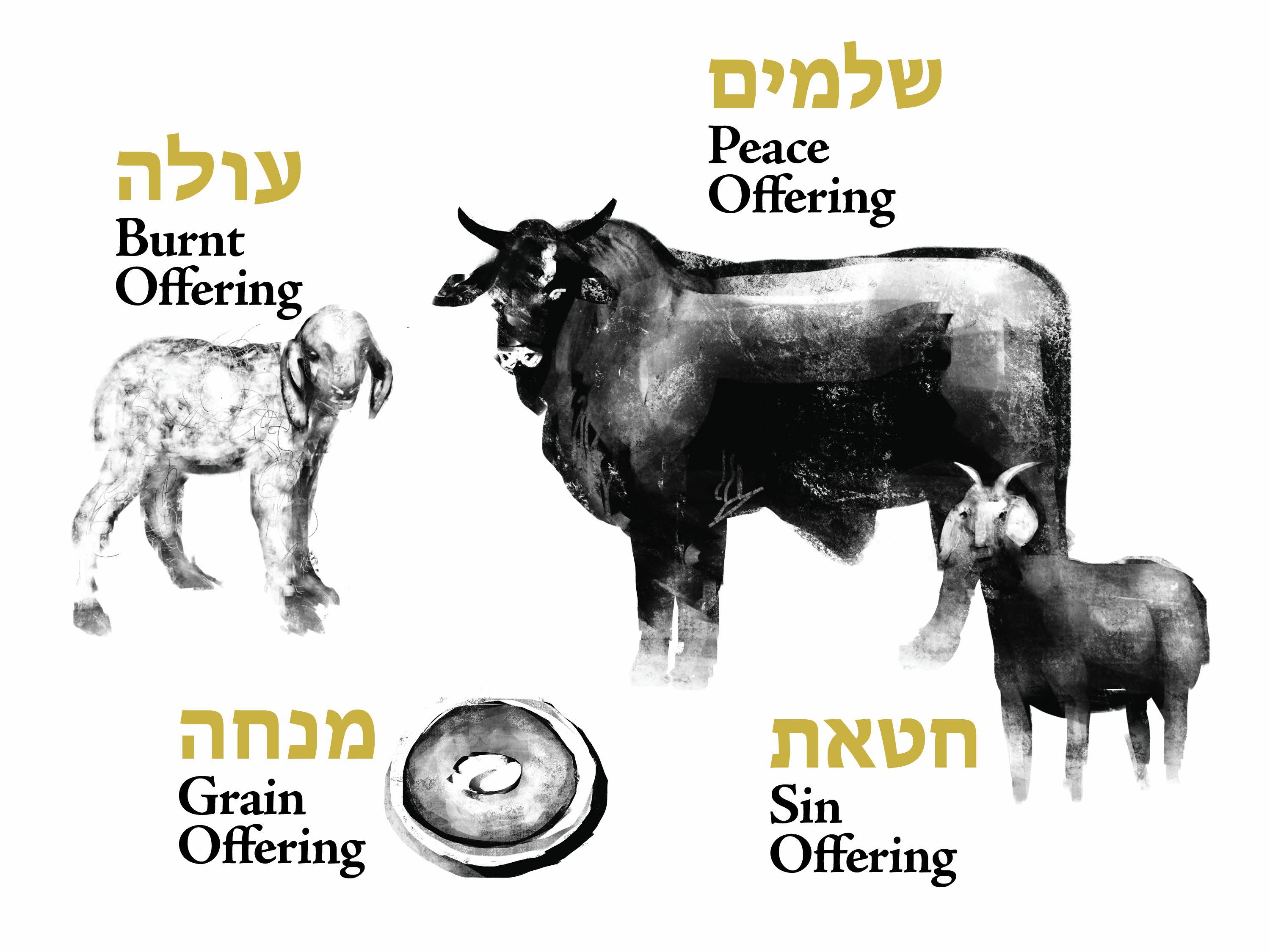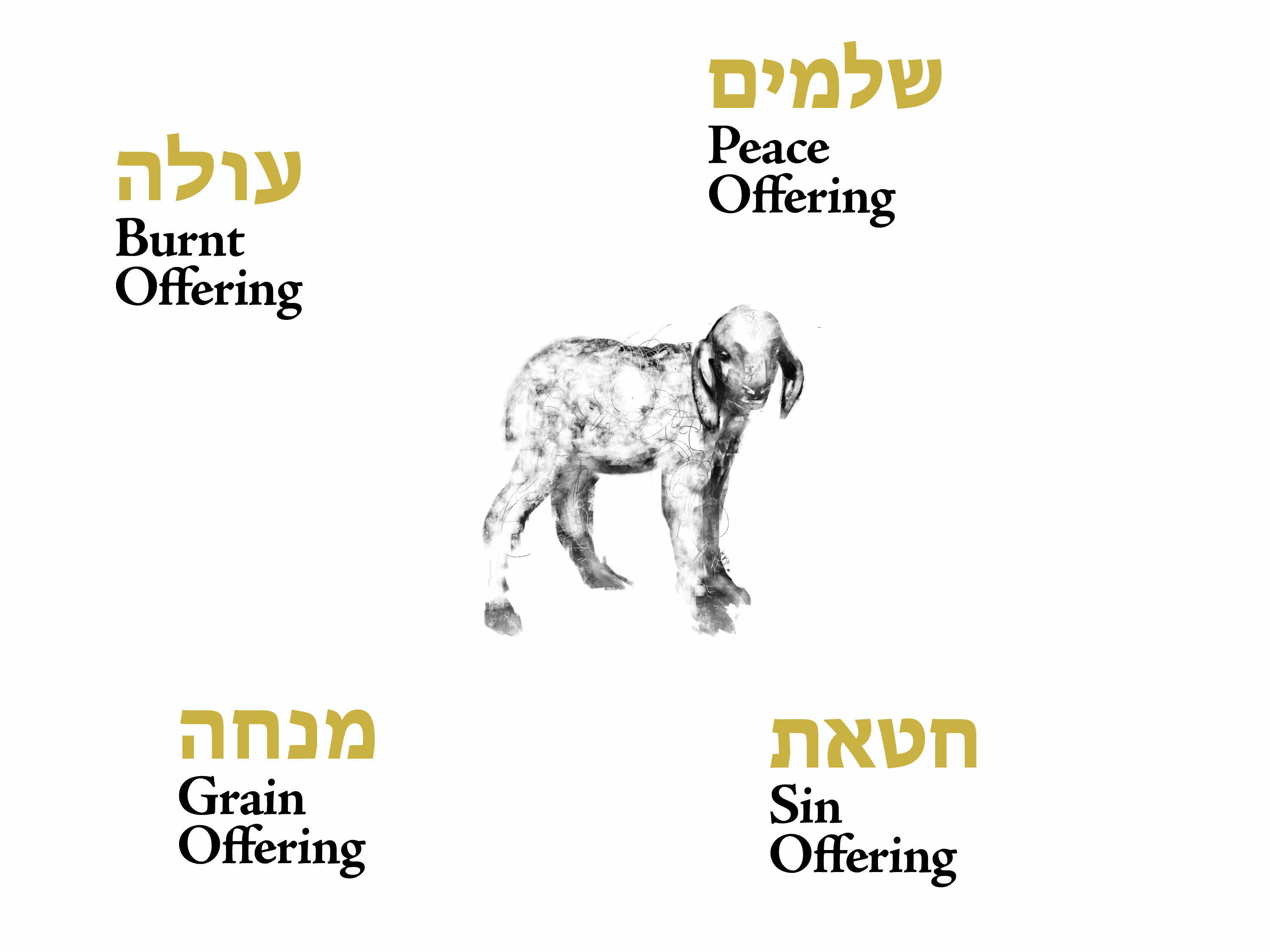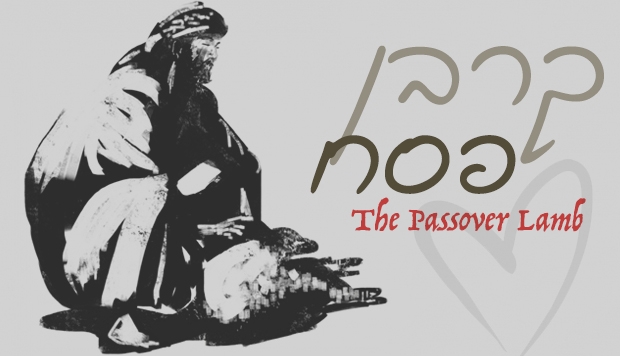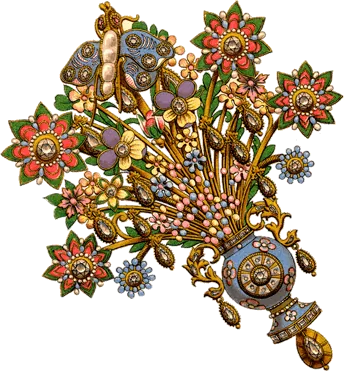The Passover Lamb is arguably one of the most accessible symbols of God’s love for us; but what if we understood Korban Pesach in terms of the context already established in Leviticus 1-6?
Commentary by Daniel Williams.
The terms of the altar
The first 6 chapters of Leviticus consist of instructions for each type of the Torah's primary offerings: Burnt offerings, Grain offerings, Peace offerings, and Sin offerings. In a way, we can view Vayikra as glossary for the worship of God.
When studying the Five Books of Moses, we often find that the Torah provides very few details. For example, many of the offerings are mentioned [specifically] by name, however, the Torah doesn't always provide a description: What does this mean? Or the procedure: How is this performed?
For many people, the Torah's lack of immediate detail is a free pass to "skim on" so to speak; without ever giving second thought or consideration for the meaning or purpose of the text. “Okay," we tell ourselves, "the Israelites performed some type of sacrifice - let's just keep reading.”
Sadly, this style of reading can lead to the erroneous conclusion that all of the Temple sacrifices were basically the same thing.
As believers in Yeshua, we often take an even easier route: “Since Yeshua was the ultimate sacrifice," we tell ourselves, "any sacrifice we read about must have to do with the specific act of exchanging an animal’s life for a person’s sin.”
Of course, we know that if we were meant to learn the same lesson from each individual offering, the Torah wouldn't have to prescribe more than one type of offering.
Because this is not the case, the reader must know that there is a certain vocabulary being established in the Torah. As foreign as it may be to the average reader (and really to anyone alive today since the world has been without the Holy Temple for 2000 years), we have to understand that God’s vocabulary establishes a connection between God and Man. And if it is indeed God’s vocabulary, then it is not primitive or arbitrary.

In order to comprehend and truly appreciate the Passover offering, we have to understand [on some level] the terminology and vocabulary established for us in Leviticus chapters 1-6. The Passover offering is arguably one of the most accessible symbols of God’s love for us; but what if we understood Korban Pesach in terms of its proper context - based on the functions of the korbanot (offerings) already established in Leviticus 1-6? In this article, we will seek to refine our understanding of Leviticus through the lens of the Passover lamb; and in turn, refine our understanding of the Passover lamb through the proper perspective of Leviticus.
The Passover lamb: completely blameless
Exodus 12:5
Your lamb shall be without blemish, a male of the first year; you shall take it from the sheep, or from the goats;
In the original text, the concept of bringing an animal without blemish is described by the Hebrew word, tammim. In the context of Exodus 12:5, tammim describes the status of being without blemish. However, the concept of tammim expresses the state of being whole, or complete. In a sense, the Torah's use of tammim could also say "innocent" or "perfectly true". The first use of this word is used to describe the character of Noah in Genesis 6:9:
This is the account of Noah and his family. Noah was a righteous man, blameless [tammim] among the people of his time, and he walked faithfully with God.
According to the Torah's terminology in Leviticus, every animal offered before the LORD must be tammim, i.e. blameless: the Burnt offering, the Peace offering, the Sin offering, and Guilt offering. To be "blameless" is truly the universal theme of drawing near to God. The reasons are obvious: God is holy and pure. It would be of no value to an impure person to offer a korban as impure as he is. No, the connecting point to God must be "blameless".

A posture of submission
The Passover lamb is to be a male of its first year. This sounds exactly like a burnt offering. There were two, year old lambs offered daily one in the morning and one in the afternoon. Perhaps this implies that the Passover lamb has a perpetual impact like the daily offerings. A year old lamb is the youngest, most innocent allowable offering from among the herds. This carries a meaning of humility. The Passover offering was not a strong bull or even a fully matured ram, but a symbol of complete weakness. An animal to be pitied. This describes the posture of Israel, huddled among the strong Egyptians for centuries. And this describes Yeshua who won his first victory from a posture of submission.
The table of God
Continuing with the connection to the Olah or burnt offering, Pesach lambs were stripped of their skin, like an Olah. Then they were cooked entirely over fire. Of course, Olah’s were consumed by God alone on the altar, but perhaps the Pesach lamb is an invitation to eat as God eats, so to speak. Maybe this is why the commandment was given for Israel to eat the lamb in His presence. It is an invitation to eat at the table of God.
Ok, let’s look at one more way the Pesach lamb is like the Olah.
Leviticus 1:9
Finally, the one presen ting the offering must wash its entrails and its legs in water and the priest must offer all of it up in smoke on the altar—it is a burnt offering, a gift of a soothing aroma to the Lord.
Pesach lambs were carefully cleaned and prepared for the four days leading up to the 14thbut there is no mention of their legs being specifically cleaned. And they were cooked with the entrails inside. At a glance there doesn’t seem to be a connection here between the Olah and the Pesach lamb. The connection, however can be found in the book of Luke:
Luke 22:3-10
Because Jesus knew that the Father had handed all things over to him, and that he had come from God and was going back to God, he got up from the meal, removed his outer clothes, took a towel and tied it around himself. He poured water into the washbasin and began to wash the disciples’ feet and to dry them with the towel he had wrapped around himself. Then he came to Simon Peter. Peter said to him, “Lord, are you going to wash my feet?” Jesus replied, “You do not understand what I am doing now, but you will understand after these things.” Peter said to him, “You will never wash my feet!” Jesus replied, “If I do not wash you, you have no share with me.” Simon Peter said to him, “Lord, wash not only my feet, but also my hands and my head!” Jesus replied, “The one who has bathed needs only to wash his feet, but is completely clean.
You see, He connects himself to the Olah and asks his disciples to join Him. Just as an Olah’s legs and insides are washed, if our insides are clean through the baptism of the Holy Spirit, we need only wash our feet to be accepted completely as an Olah, totally set apart for Him.
The Passover lamb: marking a miracle
Let’s continue our study in Exodus 12.
Exodus 12:3-4, 10
If any household is too small for a whole lamb, they must share one with their nearest neighbor, having taken into account the number of people there are. You are to determine the amount of lamb needed in accordance with what each person will eat…. Do not leave any of it till morning; if some is left till morning, you must burn it.
This sounds like a peace offering. Peace offerings were meant to be shared in the case of a great miracle — a return from a journey at sea or a near-death experience. Sounds appropriate for Passover doesn’t it? Both the Passover lamb and a peace offering were to be eaten before the following day. But why? What is the significance of this command? Let’s look at a situation where a Peace offering can be eaten after the following day. Then maybe we can see the meaning of the single day requirement.
Leviticus 7:15-16
The meat of their fellowship offering of thanksgiving must be eaten on the day it is offered; they must leave none of it till morning. If, however, their offering is the result of a vow or is a freewill offering, the sacrifice shall be eaten on the day they offer it, but anything left over may be eaten on the next day. Any meat of the sacrifice left over till the third day must be burned up.
In other words, if a peace offering is not being given due to a miracle, then it can be eaten for an additional day. This is not the situation of Passover. Waiting an additional day to finish the meal, would diminish the great miracles God has been doing in Egypt and will continue to do as they leave. This may also give us some context for the moment we enter into a relationship with Yeshua. We often think of it in terms of praying a prayer, to promise God that you will follow Him. Our initial redemption requires a willingness on our part yes, which is a commitment in and of itself, but the Passover does not require a vow, in the Biblical sense. Those would come later as a result of maturity. You see, God wants very little from us in the beginning, just an acknowledgment of thanksgiving for the miracle he is offering us. He wants a clear-cut decision. He asks, “will you acknowledge my salvation, if so, paint your doorposts with the blood of the lamb and be saved. Then tonight, walk out of Egypt with me.”
The Passover lamb: eager to die
While we’re speaking of thanksgiving, it is interesting to understand the meaning of the word pesach, because it has two. We typically understand it as passing over, as in sparing the lives of those who painted their doorposts…which is quite true. However, this appears to be a secondary meaning. We have visions of the angel of death roaming the streets, out for blood. This is the often presented, terrifying view of the God of the Old Testament. But in fact, that view of God can only be drawn from one perspective: that of the Egyptians, those who hate God.
But what is the root meaning of the word? According to the Jewish Encyclopedia, the root word describes a young lamb skipping or dancing. How can this be on such a somber night? Let’s read the words of Yeshua, our Pesach Lamb:
Luke 22:14-15
When the hour came, Jesus and his apostles reclined at the table. And he said to them, “I have eagerly desired to eat this Passover with you before I suffer.
You see, Yeshua couldn’t be happier about the opportunity to redeem His people..Like a lamb, skipping about on His way to the altar.
Understanding unleavened
But what of the unleavened bread? Leviticus tells us that:
Leviticus 2:11
Every grain offering you bring to the Lord must be made without yeast, for you are not to burn any yeast or honey in a food offering presented to the Lord.
So, of course the idea of unleavened bread is a consistent theme before God. But why? We know that sin puffs up, producing pride. And this is why leaven is to be removed from all of Israel for the week long festival of matzah. It is a time of careful examining of one’s life. So, Yeshua breaks the bread and says, “this is my body.” And he passes them this unleavened bread. Now, what is He really saying? He is saying, “priest, eat this grain offering.” Let’s read:
Leviticus 2:8-10
Bring the grain offering made of these things to the Lord; present it to the priest, who shall take it to the altar. He shall take out the memorial portion from the grain offering and burn it on the altar as a food offering, an aroma pleasing to the Lord. The rest of the grain offering belongs to Aaron and his sons; it is a most holy part of the food offerings presented to the Lord.
Clarifying wine
And what of the wine? Well, Leviticus 1-6 says nothing of wine but there were drink offerings that went with nearly every animal offered on the altar. I know tradition connects drinking wine for Passover with stages of God’s redemption. But, there is no mention of wine specifically in the Pesach account. Is this tradition misguided then? I don’t believe so. It’s hard to see, but there is wine commanded during Passover week. On the day after the Sabbath is an often-overshadowed festival: The Feast of First fruits of the barley harvest. And we find the instructions in Leviticus 23.
Leviticus 23:10-13
Speak to the Israelites and tell them, ‘When you enter the land that I am about to give to you and you gather in its harvest, then you must bring the sheaf of the first portion of your harvest to the priest, He is to wave the sheaf before the Lord so it will be accepted on your behalf; the priest is to wave it on the day after the Sabbath. On the day you wave the sheaf you must also offer a flawless yearling lamb for a burnt offering to the Lord, along with its grain offering, two tenths of an ephah of choice wheat flour mixed with olive oil, as a gift to the Lord, a soothing aroma, and its drink offering, one fourth of a hin of wine.
Okay, so the first thing to know is Israel could not celebrate this festival until they were planted in the land. And then, part of the celebration would be to offer a blameless lamb, for a burnt offering, with an unleavened grain offering. Sounds a lot like the components of Passover. But what’s missing? There’s no bitter herbs like Pesach. Instead, there is the fresh harvest, the first fruits of the season. And the blood on the door posts? No, the lamb is not eaten and there is no painting of blood. But instead there is this drink offering of wine.
The word for drink offering is Nesech and is formed from the verb nasach which means to pour out.
Luke 22: 20
And in the same way he took the cup after they had eaten, saying, “This cup that is poured out for you is the new covenant in my blood.
You see the wine is a celebration of new life. In a word: resurrection. Yeshua’s blood spilled was the most unjust tragedy of all time. Yet, when viewed as a drink offering it symbolizes new life, the first fruits springing up, a celebration.
Okay, so we can see that the Pesach Lamb is truly the ultimate offering, it contains parts of each of the major offerings. But there is still one offering we have overlooked so far.
The Passover lamb: sin offering
The sin offering.
The connection here is quite simple, the covering of one’s sin by blood. Life for life. This is what we usually imagine when we think of what Yeshua did for us as the lamb who was slain.
It's an abstract thought, but spiritually speaking, I think it would be better to be the lamb than the person offering the sin offering. Why? Because the lamb takes on your sin and then is declared holy by God. The worshipper is forgiven yes, but the lamb is a picture of the spotless Messiah. And for lambs, you can't do any better than that. Actually, for people you can't do any better than that either.
So, the motives of the worshipper are important here. This can't be an effort to save one's own skin, because that would be selfish and prideful. No, the worshipper must have a heart of true sadness for his sin, how it severed him from God, and then he must recognize that there is no other path to draw near available to him. He finds himself back in Egypt, vulnerable to the plagues and the darkness. So, what do we do? We give something that we do not deserve to give. The death of an innocent life — a blameless one, in place of ours. We realize there is no moral superiority. In fact we envy the little lamb, breathing calmly, willing to lay his life down for something he did not do.
So, we can see that killing the lamb is an act of true humility because to kill one on your behalf is to acknowledge its holiness where yours is lacking.
All of this can be understood through the three main components of Pesach. The bitter herbs of our self-inflicted bondage to this world, the humbled heart of the unleavened bread and the willing innocence of the spotless lamb.
The Passover lamb: ultimate sacrifice
So, why is the Passover Lamb the ultimate sacrifice? Because it is so resurrective. Without question, the sins of Egypt were so great, that they had reached God's final judgment. That night, death was coming. In other words, God had reached some limit. At the point where a human heart has become so opposed to the promptings of God, that to do nothing Would infringe on God's own nature. I don't know how to put this into words exactly, but it may be the tipping point wherein if God did not intervene, the authority of God would have to diminish in order for defiant man to continue. In short, man forces God’s hand; as in the flood, as in Sodom and Gomorrah, as in the end of days.
How does God intervene though? We can only imagine it in symbolic terms, but in Torah you have the idea of God's face. In other words, his full attention. And when His attention is fully introduced, there is a cut made. It divides like the sharpest sword. And it is so sudden. When the face of God intervenes, there is death and...at the same instant there is life. Redemption. How does this play out? With a final chance. Get on the ark. Get out of the city. Paint your door posts. Because the flood is coming, the fire will fall and the angel will pass by.


